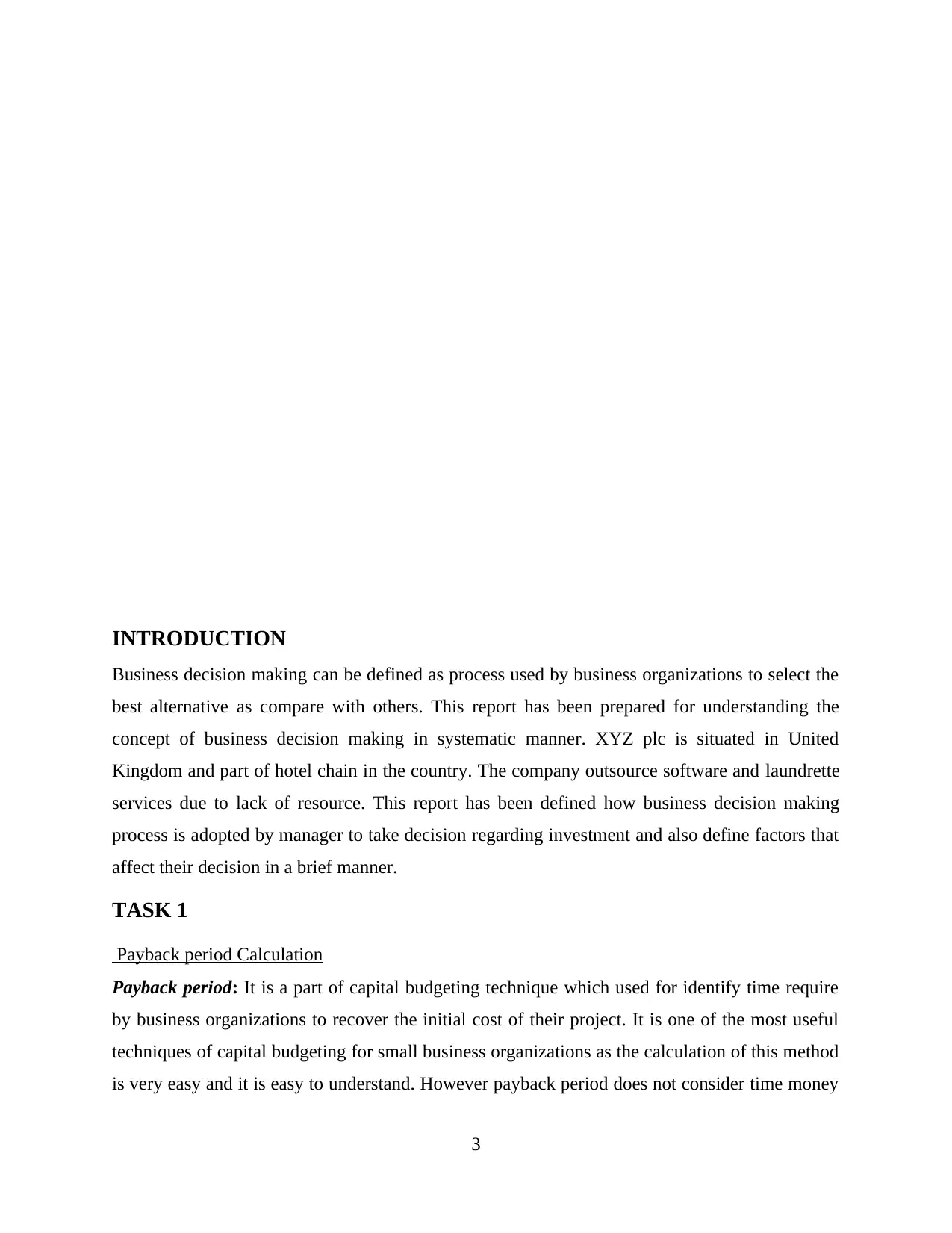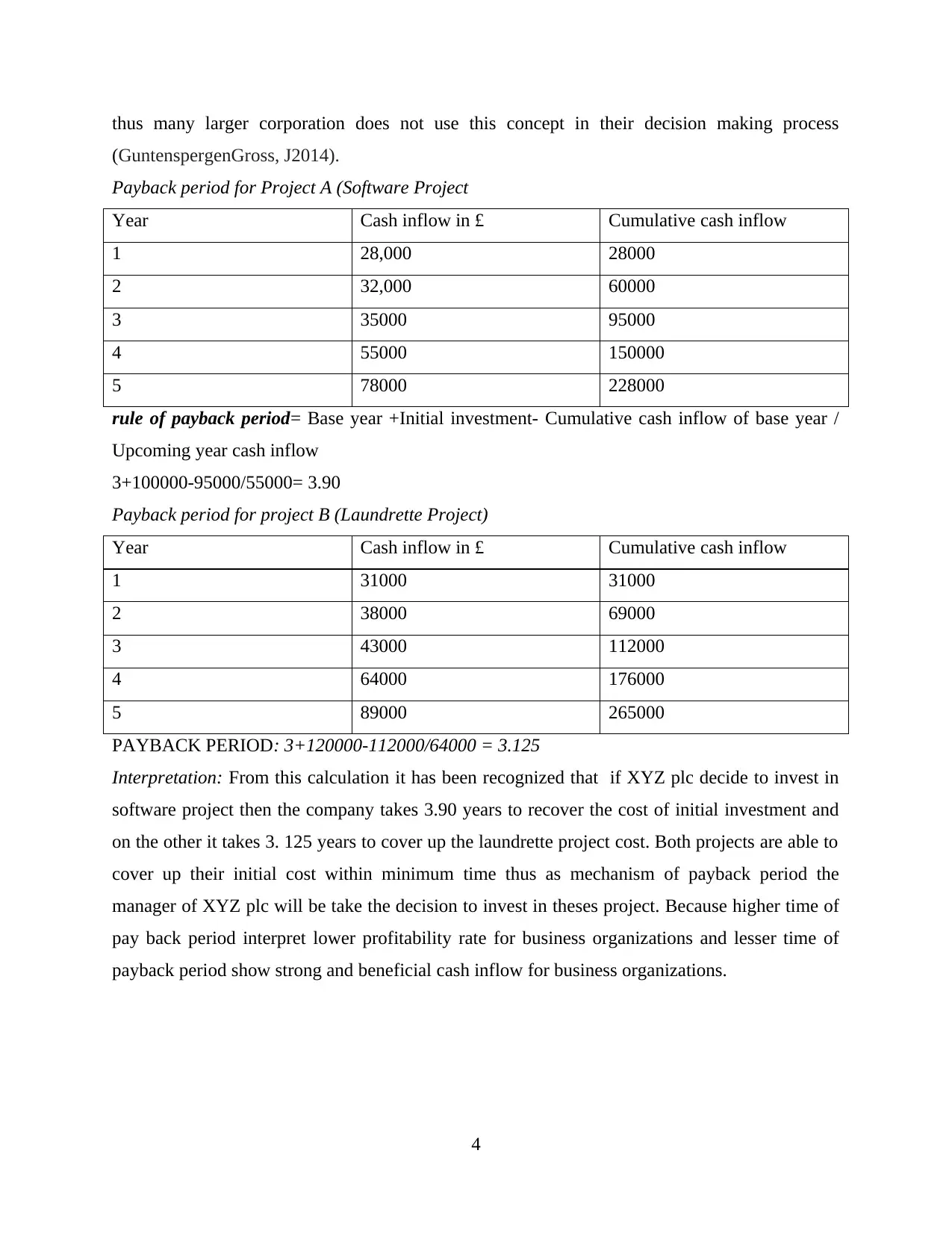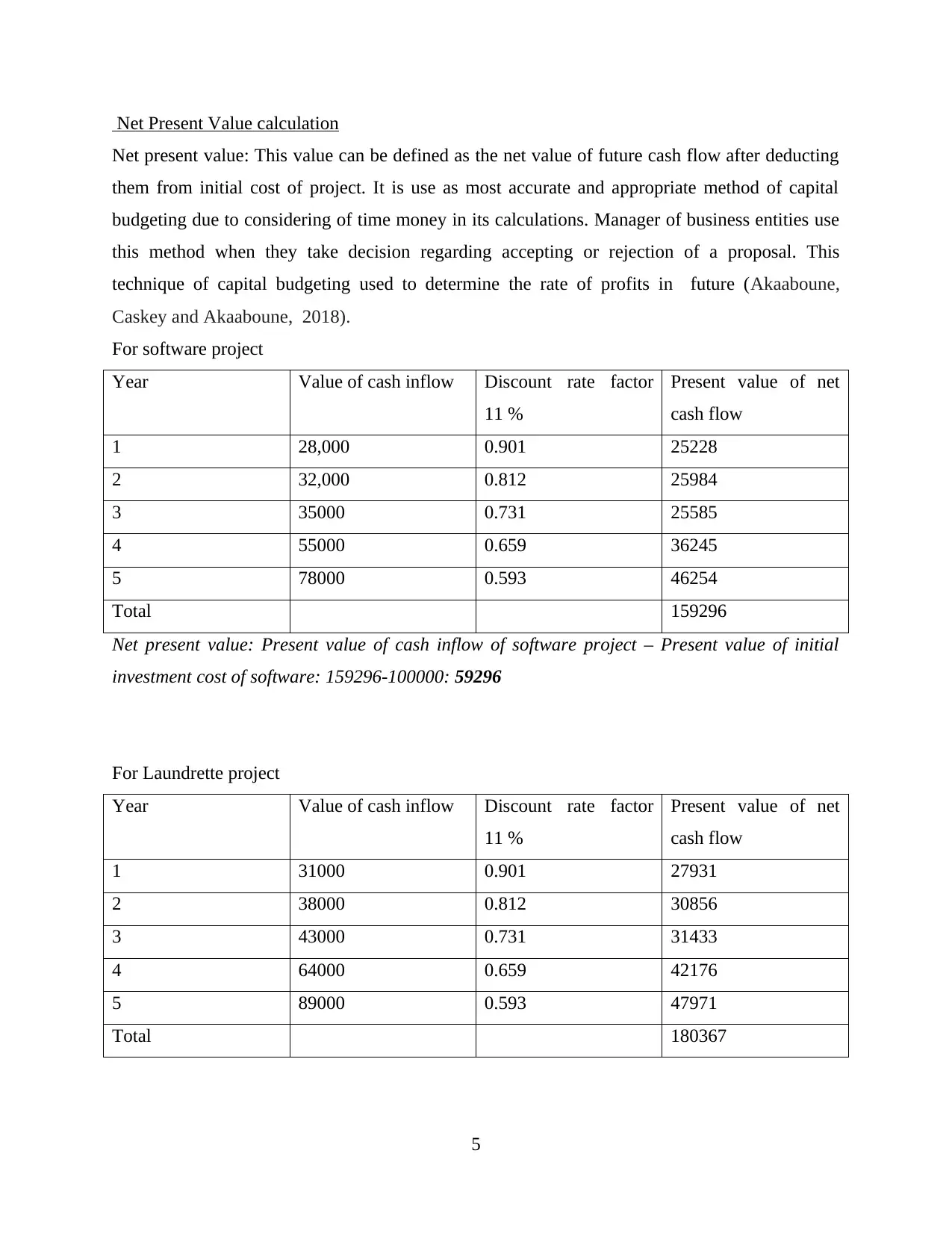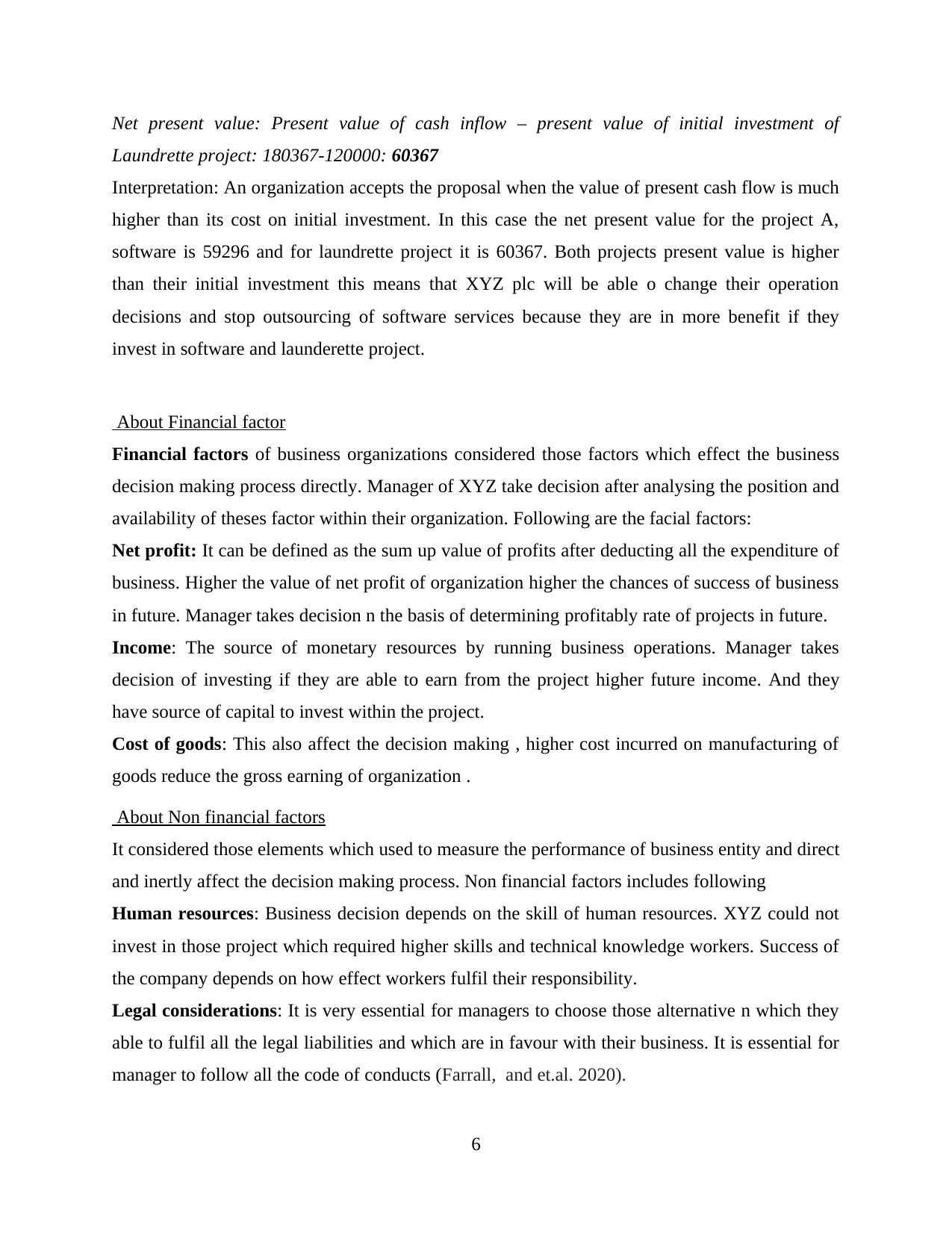Business Decision Making: Applying NPV and Payback Period Analysis
VerifiedAdded on 2023/01/11
|7
|1333
|54
Report
AI Summary
This report explores business decision-making processes, focusing on XYZ plc's investment choices. It details the payback period and net present value (NPV) calculations for software and laundrette projects, interpreting the results to inform investment decisions. The report also discusses financia...

BUSINESS DECISION
MAKING
1
MAKING
1
Paraphrase This Document
Need a fresh take? Get an instant paraphrase of this document with our AI Paraphraser

Contents
Contents...........................................................................................................................................2
INTRODUCTION...........................................................................................................................3
TASK 1............................................................................................................................................3
Payback period Calculation.........................................................................................................3
Net Present Value calculation......................................................................................................3
About Financial factor.................................................................................................................3
About Non financial factors.........................................................................................................3
CONCLUSION................................................................................................................................3
REFRENCES...................................................................................................................................3
2
Contents...........................................................................................................................................2
INTRODUCTION...........................................................................................................................3
TASK 1............................................................................................................................................3
Payback period Calculation.........................................................................................................3
Net Present Value calculation......................................................................................................3
About Financial factor.................................................................................................................3
About Non financial factors.........................................................................................................3
CONCLUSION................................................................................................................................3
REFRENCES...................................................................................................................................3
2

INTRODUCTION
Business decision making can be defined as process used by business organizations to select the
best alternative as compare with others. This report has been prepared for understanding the
concept of business decision making in systematic manner. XYZ plc is situated in United
Kingdom and part of hotel chain in the country. The company outsource software and laundrette
services due to lack of resource. This report has been defined how business decision making
process is adopted by manager to take decision regarding investment and also define factors that
affect their decision in a brief manner.
TASK 1
Payback period Calculation
Payback period: It is a part of capital budgeting technique which used for identify time require
by business organizations to recover the initial cost of their project. It is one of the most useful
techniques of capital budgeting for small business organizations as the calculation of this method
is very easy and it is easy to understand. However payback period does not consider time money
3
Business decision making can be defined as process used by business organizations to select the
best alternative as compare with others. This report has been prepared for understanding the
concept of business decision making in systematic manner. XYZ plc is situated in United
Kingdom and part of hotel chain in the country. The company outsource software and laundrette
services due to lack of resource. This report has been defined how business decision making
process is adopted by manager to take decision regarding investment and also define factors that
affect their decision in a brief manner.
TASK 1
Payback period Calculation
Payback period: It is a part of capital budgeting technique which used for identify time require
by business organizations to recover the initial cost of their project. It is one of the most useful
techniques of capital budgeting for small business organizations as the calculation of this method
is very easy and it is easy to understand. However payback period does not consider time money
3
⊘ This is a preview!⊘
Do you want full access?
Subscribe today to unlock all pages.

Trusted by 1+ million students worldwide

thus many larger corporation does not use this concept in their decision making process
(GuntenspergenGross, J2014).
Payback period for Project A (Software Project
Year Cash inflow in £ Cumulative cash inflow
1 28,000 28000
2 32,000 60000
3 35000 95000
4 55000 150000
5 78000 228000
rule of payback period= Base year +Initial investment- Cumulative cash inflow of base year /
Upcoming year cash inflow
3+100000-95000/55000= 3.90
Payback period for project B (Laundrette Project)
Year Cash inflow in £ Cumulative cash inflow
1 31000 31000
2 38000 69000
3 43000 112000
4 64000 176000
5 89000 265000
PAYBACK PERIOD: 3+120000-112000/64000 = 3.125
Interpretation: From this calculation it has been recognized that if XYZ plc decide to invest in
software project then the company takes 3.90 years to recover the cost of initial investment and
on the other it takes 3. 125 years to cover up the laundrette project cost. Both projects are able to
cover up their initial cost within minimum time thus as mechanism of payback period the
manager of XYZ plc will be take the decision to invest in theses project. Because higher time of
pay back period interpret lower profitability rate for business organizations and lesser time of
payback period show strong and beneficial cash inflow for business organizations.
4
(GuntenspergenGross, J2014).
Payback period for Project A (Software Project
Year Cash inflow in £ Cumulative cash inflow
1 28,000 28000
2 32,000 60000
3 35000 95000
4 55000 150000
5 78000 228000
rule of payback period= Base year +Initial investment- Cumulative cash inflow of base year /
Upcoming year cash inflow
3+100000-95000/55000= 3.90
Payback period for project B (Laundrette Project)
Year Cash inflow in £ Cumulative cash inflow
1 31000 31000
2 38000 69000
3 43000 112000
4 64000 176000
5 89000 265000
PAYBACK PERIOD: 3+120000-112000/64000 = 3.125
Interpretation: From this calculation it has been recognized that if XYZ plc decide to invest in
software project then the company takes 3.90 years to recover the cost of initial investment and
on the other it takes 3. 125 years to cover up the laundrette project cost. Both projects are able to
cover up their initial cost within minimum time thus as mechanism of payback period the
manager of XYZ plc will be take the decision to invest in theses project. Because higher time of
pay back period interpret lower profitability rate for business organizations and lesser time of
payback period show strong and beneficial cash inflow for business organizations.
4
Paraphrase This Document
Need a fresh take? Get an instant paraphrase of this document with our AI Paraphraser

Net Present Value calculation
Net present value: This value can be defined as the net value of future cash flow after deducting
them from initial cost of project. It is use as most accurate and appropriate method of capital
budgeting due to considering of time money in its calculations. Manager of business entities use
this method when they take decision regarding accepting or rejection of a proposal. This
technique of capital budgeting used to determine the rate of profits in future (Akaaboune,
Caskey and Akaaboune, 2018).
For software project
Year Value of cash inflow Discount rate factor
11 %
Present value of net
cash flow
1 28,000 0.901 25228
2 32,000 0.812 25984
3 35000 0.731 25585
4 55000 0.659 36245
5 78000 0.593 46254
Total 159296
Net present value: Present value of cash inflow of software project – Present value of initial
investment cost of software: 159296-100000: 59296
For Laundrette project
Year Value of cash inflow Discount rate factor
11 %
Present value of net
cash flow
1 31000 0.901 27931
2 38000 0.812 30856
3 43000 0.731 31433
4 64000 0.659 42176
5 89000 0.593 47971
Total 180367
5
Net present value: This value can be defined as the net value of future cash flow after deducting
them from initial cost of project. It is use as most accurate and appropriate method of capital
budgeting due to considering of time money in its calculations. Manager of business entities use
this method when they take decision regarding accepting or rejection of a proposal. This
technique of capital budgeting used to determine the rate of profits in future (Akaaboune,
Caskey and Akaaboune, 2018).
For software project
Year Value of cash inflow Discount rate factor
11 %
Present value of net
cash flow
1 28,000 0.901 25228
2 32,000 0.812 25984
3 35000 0.731 25585
4 55000 0.659 36245
5 78000 0.593 46254
Total 159296
Net present value: Present value of cash inflow of software project – Present value of initial
investment cost of software: 159296-100000: 59296
For Laundrette project
Year Value of cash inflow Discount rate factor
11 %
Present value of net
cash flow
1 31000 0.901 27931
2 38000 0.812 30856
3 43000 0.731 31433
4 64000 0.659 42176
5 89000 0.593 47971
Total 180367
5

Net present value: Present value of cash inflow – present value of initial investment of
Laundrette project: 180367-120000: 60367
Interpretation: An organization accepts the proposal when the value of present cash flow is much
higher than its cost on initial investment. In this case the net present value for the project A,
software is 59296 and for laundrette project it is 60367. Both projects present value is higher
than their initial investment this means that XYZ plc will be able o change their operation
decisions and stop outsourcing of software services because they are in more benefit if they
invest in software and launderette project.
About Financial factor
Financial factors of business organizations considered those factors which effect the business
decision making process directly. Manager of XYZ take decision after analysing the position and
availability of theses factor within their organization. Following are the facial factors:
Net profit: It can be defined as the sum up value of profits after deducting all the expenditure of
business. Higher the value of net profit of organization higher the chances of success of business
in future. Manager takes decision n the basis of determining profitably rate of projects in future.
Income: The source of monetary resources by running business operations. Manager takes
decision of investing if they are able to earn from the project higher future income. And they
have source of capital to invest within the project.
Cost of goods: This also affect the decision making , higher cost incurred on manufacturing of
goods reduce the gross earning of organization .
About Non financial factors
It considered those elements which used to measure the performance of business entity and direct
and inertly affect the decision making process. Non financial factors includes following
Human resources: Business decision depends on the skill of human resources. XYZ could not
invest in those project which required higher skills and technical knowledge workers. Success of
the company depends on how effect workers fulfil their responsibility.
Legal considerations: It is very essential for managers to choose those alternative n which they
able to fulfil all the legal liabilities and which are in favour with their business. It is essential for
manager to follow all the code of conducts (Farrall, and et.al. 2020).
6
Laundrette project: 180367-120000: 60367
Interpretation: An organization accepts the proposal when the value of present cash flow is much
higher than its cost on initial investment. In this case the net present value for the project A,
software is 59296 and for laundrette project it is 60367. Both projects present value is higher
than their initial investment this means that XYZ plc will be able o change their operation
decisions and stop outsourcing of software services because they are in more benefit if they
invest in software and launderette project.
About Financial factor
Financial factors of business organizations considered those factors which effect the business
decision making process directly. Manager of XYZ take decision after analysing the position and
availability of theses factor within their organization. Following are the facial factors:
Net profit: It can be defined as the sum up value of profits after deducting all the expenditure of
business. Higher the value of net profit of organization higher the chances of success of business
in future. Manager takes decision n the basis of determining profitably rate of projects in future.
Income: The source of monetary resources by running business operations. Manager takes
decision of investing if they are able to earn from the project higher future income. And they
have source of capital to invest within the project.
Cost of goods: This also affect the decision making , higher cost incurred on manufacturing of
goods reduce the gross earning of organization .
About Non financial factors
It considered those elements which used to measure the performance of business entity and direct
and inertly affect the decision making process. Non financial factors includes following
Human resources: Business decision depends on the skill of human resources. XYZ could not
invest in those project which required higher skills and technical knowledge workers. Success of
the company depends on how effect workers fulfil their responsibility.
Legal considerations: It is very essential for managers to choose those alternative n which they
able to fulfil all the legal liabilities and which are in favour with their business. It is essential for
manager to follow all the code of conducts (Farrall, and et.al. 2020).
6
⊘ This is a preview!⊘
Do you want full access?
Subscribe today to unlock all pages.

Trusted by 1+ million students worldwide

Technology: The system, equipments and technology use by company to offer goods and check
is as well effect performance of organization
CONCLUSION
From this report it can be concluded that for taking decision regarding future business policies
managers use business decision-making procedure. In which they use mechanism of payback
period and net present values, these methods help in determine future profitability rate and time
taken to recovered the cost .Manager also considered financial and no financial factors to select
best alternative for their business.
REFRENCES
Books and journals
Malik, M. G. A., Ray, S. K., Bashir, Z. and Mughal, A., 2018, October. Selecting Ubiquitous
Services in Future Heterogenous Wireless Networks using Multi-Attributes Decision Making.
In 2018 Eleventh International Conference on Mobile Computing and Ubiquitous Network
(ICMU) (pp. 1-4). IEEE.
Guntenspergen, G .R. and Gross, J., 2014. Threshold concepts: implications for the management
of natural resources. In Application of threshold concepts in natural resource decision
making (pp. 1-7). Springer, New York, NY.
Akaaboune, A., Caskey, K. and Akaaboune, O., 2018. Third-Party Logistics Provider Choice in
Emerging Markets. Journal of Competitiveness Studies, 26(3-4), pp.134-152.
Farrall, J., Loiselle, M. E., Michaelsen, C., Prantl, J. and Whalan, J., 2020. Elected member
influence in the United Nations Security Council. Leiden Journal of International Law, 33(1),
pp.101-115.
7
is as well effect performance of organization
CONCLUSION
From this report it can be concluded that for taking decision regarding future business policies
managers use business decision-making procedure. In which they use mechanism of payback
period and net present values, these methods help in determine future profitability rate and time
taken to recovered the cost .Manager also considered financial and no financial factors to select
best alternative for their business.
REFRENCES
Books and journals
Malik, M. G. A., Ray, S. K., Bashir, Z. and Mughal, A., 2018, October. Selecting Ubiquitous
Services in Future Heterogenous Wireless Networks using Multi-Attributes Decision Making.
In 2018 Eleventh International Conference on Mobile Computing and Ubiquitous Network
(ICMU) (pp. 1-4). IEEE.
Guntenspergen, G .R. and Gross, J., 2014. Threshold concepts: implications for the management
of natural resources. In Application of threshold concepts in natural resource decision
making (pp. 1-7). Springer, New York, NY.
Akaaboune, A., Caskey, K. and Akaaboune, O., 2018. Third-Party Logistics Provider Choice in
Emerging Markets. Journal of Competitiveness Studies, 26(3-4), pp.134-152.
Farrall, J., Loiselle, M. E., Michaelsen, C., Prantl, J. and Whalan, J., 2020. Elected member
influence in the United Nations Security Council. Leiden Journal of International Law, 33(1),
pp.101-115.
7
1 out of 7
Related Documents
Your All-in-One AI-Powered Toolkit for Academic Success.
+13062052269
info@desklib.com
Available 24*7 on WhatsApp / Email
![[object Object]](/_next/static/media/star-bottom.7253800d.svg)
Unlock your academic potential
© 2024 | Zucol Services PVT LTD | All rights reserved.





